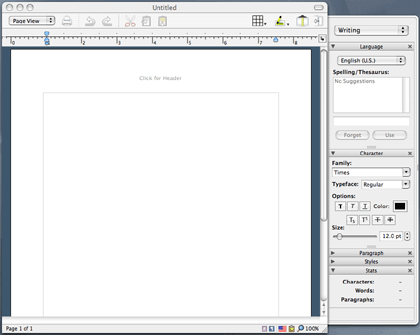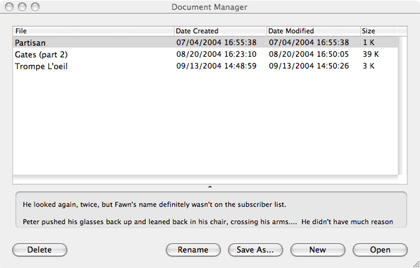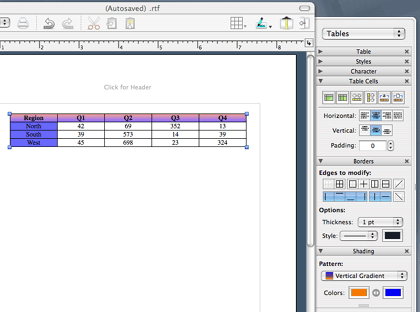Review: Nisus Writer Express 2.0

Developer: Nisus Software, Inc.
Price: $70 (boxed); $60 (download); $45 (upgrade)
Requirements: Mac OS X 10.2.8
Trial: Fully-featured (30 days)
From its first release in 1989, Nisus Writer gained a following as a power user’s word processor in the pre-OS X world for its sophisticated macro capability, regular expression-based PowerFind, non-contiguous text selection, and other features that, 15 years later, are still rare.
With the advent of OS X, Nisus faced a choice of Carbonizing Nisus Writer or starting over with a Cocoa-based application. Concurrently, independent developer Charles Jolley was working on a word processor called Okito Composer that, while aimed at the low-end market, took full advantage of OS X technologies. Nisus bought Composer, hired Jolley, added some of Nisus Writer’s unique features, and released Nisus Writer Express 1.0 in 2003.
The original release of NWX was promising, but it lacked in both features and performance and met with lukewarm response from new users and disappointment from old Nisus fans. In September 2004, Nisus introduced Express 2.0, adding some of the most-requested features including styles, tables, and footnotes. This helps make NWX competitive with other alternative word processors—but it’s the unique features that set it apart from the competition.
Overview

Document Window and Tool Drawer
NWX’s most distinctive user interface feature is the tool drawer, which contains different sets of palettes that can be grouped together. In this screen shot, the group is named Writing. In addition to collapsing palettes as shown, the palettes can be rearranged within a group, put into new groups, and even dragged out of the drawer completely.
NWX also has a standard Cocoa toolbar (shown above in the small icon, no text view). It offers a relatively limited set of icons beyond the default set shown.
In the bottom right of the window in the status bar you’ll see a series of small icons, which NWX calls “tags.” Some tags are always present—the magnifying glass and percentage show the zoom level, the flag shows the current language, and the clipboard allows access to NWX’s multiple clipboards, including the ability to edit them in separate full editor windows. Most of the other tags appear as needed to provide context-sensitive selection capability. A color-filled circle will appear to let you select all the document text that’s the same color as the current selection if it’s different than the document default; an underlined “a” selects character formatting such as underline and italics; a ruler (which longtime Nisus Writer users will recognize) selects for tabs and margins. While tags aren’t even mentioned in NWX’s feature list, they may be one of the program’s most powerful features.

Document Manager
The document manager window is also an unusual NWX feature; it “manages” documents in a single folder, Nisus Documents (stored in your Documents folder). Documents will be autosaved with filenames equivalent to their first few words, and a Preference option can direct NWX to automatically place new files in the Manager.
Using Nisus Writer Express
The style implementation is straightforward, with styles divided into paragraph and character formats. However, NWX lets you view and modify the style sheet for your document as a separate view that occupies the whole document window.
Styles can be created by defining them in the style sheet or by using the New With Selection option in the Styles palette. Styles are fully hierarchical and can be easily edited in the style sheet view—even to the point of saving new snippets of sample text with each one. All styles can also have keyboard shortcuts defined for them.

Table Tool Drawer
Tables are extremely well implemented. The button on the toolbar lets you specify table size and mark the top row as the header with two clicks; the table palettes allow other aspects—from borders to text formatting—to be modified quickly and efficiently. You can set two background colors, which will be used in patterns, gradients, and blends.
The Find/Replace functions in NWX are among the most powerful you’ll find in a word processor. PowerFind builds regular expressions from a pop-up palette, giving you all the power without the fiddly Unix syntax. If you want to replace all the occurrences of “lemon pie” and “peach pie” with “lemon tart” and “peach tart” but leave all the other pies alone, you can do that in one step. And, if you know the fiddly Unix syntax, PowerFind Pro lets you enter it directly: search for “(peach|lemon) pie” and replace it with “\1 tart.” Naturally, you can get considerably more complex than this. This power is normally found only in programmers’ text editors such as BBEdit and Emacs.
One interesting feature in the Find window is a Find All button, which selects all of the occurrences of the search term in your document at once. While NWX 2.0 lacks the ability to do a direct search and replace on styles, between Find All and the status bar tags it’s very easy to change all the occurrences of a word in the document to a new character style or replace all underlines with italics.
The language pop-up in the status bar can be hooked into OS X’s language palette to automatically switch fonts and input methods when you switch languages. NWX’s spelling dictionaries are tied to the currently chosen language, and it allows “languages” such as “Tech” to be defined that prevent it from performing a spellcheck within blocks of code. NWX also has a real-time thesaurus and dictionary: stop typing for a moment (or make a selection), and it will show you either suggested spellings or suggested alternative words. This is another unique feature, going beyond the real-time word-counting function it also provides. NWX’s only major weakness in language handling for most users will be its lack of hyphenation dictionaries; it doesn’t seem to support manual hyphenation with soft hyphens.
NWX also has a few features that, while they aren’t unique, mean you won’t miss them if you move from another word processor. It supports “smart” quotes and automatic correction of common typing errors. Unusually, it also supports dictionary-based word completion: type the first part of a word and press Option-Escape, and a pop-up list box of possible completions appears. In Preferences, you can set this feature to be on all the time (which strikes me as a terrible idea for both program performance and writing flow).
NWX’s other Preferences allow you to configure and name its multiple clipboards, control language settings, and set new document defaults—which can also be configured by using a template file. (As with Microsoft Word, any file can be saved as a template. While NWX’s manual refers to using the Stationery checkbox in the Finder’s Get Info for this purpose, in my experience, you must save the file from within NWX as a template.) You can also set the keyboard shortcuts for any menu item, although the preferences do not let you change editing keys.
Scriptability
While the original Nisus Writer macro language is a thing of the past, NWX takes advantage of OS X’s Unix nature to offer another interesting approach: you can write macro scripts in Perl. I’ve already put this to use with a script to do simple conversions from Nisus documents to John Gruber’s Markdown formatter, which I use in an online magazine I publish.
Currently, the support for Perl has limitations—its support for formatted text is limited, and not all of the documented NWX-specific directives work as advertised. Even so, some users will already find it a welcome alternative to AppleScript or Word’s internal Visual Basic.
NWX can also be scripted in AppleScript, although its dictionary is extremely basic compared to some of its competitors such as Mariner Write and Microsoft Word.
Problems and Missing Features
Nisus Writer Express 2.0 has no way of doing automatic bulleted or numbered lists. While it’s easy to do bullets with hanging indents, there is no way to do outlines or other lists that require automatic numbering. You can export RTF from a stand-alone outliner, but NWX doesn’t read OPML directly. In fact, there’s no automatic list generation in NWX at all. You can’t create tables of contents, indexes, or lists of figures.
The original Nisus Writer handled graphics through a “graphics layer,” which could be placed over or under text. NWX can only handle imported graphics as inline text and has no ability to set text flow around images (or tables).
While I’m impressed overall with the Find/Replace implementation, the first version of NWX displayed all the results of a Find operation in a Search drawer, letting you quickly scan the results without changing your place in the document and clicking on any result to navigate to that point. This was a great idea, and its removal from the second version is a step backward, not forward.
NWX doesn’t have a split bar to let you see the same document in two (or more) places at once. And, it has no special features for correspondence, such as mailing lists or envelope printing. In more specialized features, there’s no way to track revisions or do document comparisons (a “diff” feature). It has no functions for formatting mathematical formulas and no automation functions for bibliographies. As with outlines, you can use external programs to do some of these functions, but they may not integrate very elegantly.
The most common complaint with NWX 2.0—and a problem I’ve noticed myself—is speed. It is slow opening files and even slower scrolling them, although editing in draft view can be considerably faster. And, even after the 2.01 release, it still has some stability issues. It doesn’t crash that frequently, but it does crash on occasion. Turning on autosave is definitely a must.
NWX has an extensive manual, available both as an Apple Help file and as a downloadable PDF. While the manual is complete, it’s not terribly well organized and is in need of proofing and much greater need of good layout. The Mac Help file is prettier, but unsearchable, so you’re better off with the PDF.
File Compatibility
Nisus Writer Express uses RTF as its native format—you can send an Express document to a Word user without saving it as a Word file, and it will open correctly. (In fact, NWX’s Save as Word function appears to change nothing but the file extension from the normal save command.) This is a boon if you need to import files into other applications, such as a desktop publishing program; they already know NWX’s format. InDesign, at least, even imports style names correctly.
Reading actual Word .doc files with NWX, though, is another matter. I tested it with a few sample files: a very simple fiction manuscript, my resumé, and a complex manual I did on a technical writing contract. Even a moderately simple document isn’t likely to be imported without some conversion errors. And, NWX won’t read old Word documents (from version 5.1, for instance) at all.
But, this must be seen in perspective. I tested the same files with Mariner Write 3.6, AppleWorks 6.2, Ragtime Solo 5.6, Mellel 1.8, OpenOffice.org’s NeoOffice/J 1.1, and AbiWord 2.2. None of them imported any of the documents without flaws that ranged from inconvenient to crippling. And none of them were able to read the Word 5.1 document, either.
If your non-negotiable requirements for a word processor include the ability to read and write Word documents as perfectly as Word itself does, you simply need to buy Word. If you get an alternative word processor, purchase it for its own sake, not because you really want a lower-cost Microsoft Word clone.
Conclusion
Nisus Writer Express isn’t—yet—the power user’s word processor its namesake was. But it shows a high attention to detail in what really matters: the act of writing. And, more than any of the alternatives—Mellel, Mariner Write, Microsoft Word itself—it has a high quality of “Mac-ness.” Express just feels right in a way that no Mac word processor has to me since the venerable WriteNow. If you’re looking for a writer’s word processor from a responsive company, definitely take a look at Nisus Writer Express.
Reader Comments (11)
Thanks to an Adam Engst tip, I had found out about the live thesaurus, which I find extremely useful but unobtrusive. So now I'm wondering what kind of workflow makes sense. Write in Nisus first, then switch to Mellel for inserting citations?
In any case, it's a tribute to the Mac platform that there are at least 3 viable word processors available whose combined cost is less than that of Microsoft Word.
Like Rick I bought both Nisus NWE and Mellel, and split my work between them depending on projects. I like so many things about Mellel, but have been drawn more and more to NWE, especially with the latest improvements. I had used Nisus in OS 8 and 9 for the past 6 years and just enjoyed writing with it (until June of this year). Even though NWE is a completely different animal, it is approaching that same feel.
For me the major lack with both programs: cross-referencing and graphics ability, and both sets of programmers are working to incorporate these capabilities. A win-win situation!
I find myself in a similar situation to Rick and Rich. It's nice to play around with NWE whenever there's a new version, and I kind of "hanker" for it to be like the old Nisus Writer (except for those bugs we now tend to blissfully forget...), but after almost three of unfulfilled promises I find myself close to losing my faith.
It's one thing that there is only meagre progress in terms of "real" features I need for work. But that those features we do get don't work is quite unacceptable. I mean, all the features do work, of course, but sometimes they don't, and other times they kind of work or work only intermitently, and so on. Vanishing footnotes, changing margins, styles that come and go, crashes.
So it turns out that for me it's playing around with NWE whenever there's a new version, and "hankering" for it to be like the old Nisus Writer, but when I need the work done, I end up working with Mellel.
:-) Jon
The user interface design is very good and I like it, but it keeps crashing. I think it has something to do with using the built in Endnotes functions. Seems to work fine until an Endnote is deleted - thereafter the stability is awful. This may or may not be caused by the Endnotes function - useful error messages are non existent so I cannot tell what the root cause is.
NSX also crashed while I was reducing the paragraph line spacing.
I'm scared that I'll lose the lot so I set it to autosave every 2 minutes. The document is simple text, 4000 words using 2 Heading styles and Normal style for the body of the document. No pictures, no tables, no columns.
Overall my impression is that Version 2.1.1 is not for me but I like the user interface and I would use it if it was stable. I don't want more features - just rock solid stability / reliability.
Regards, Keith Wilson
Add A Comment